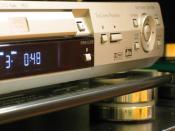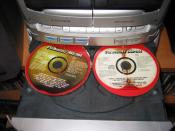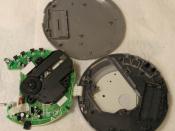CD Technology
What is it?
Compact Disc's (CD's) are a part of everyday life, they are everywhere. CD's were first introduced in the early 1980's as a convienient way to store music. Now they are mainly used to hold music, data or computer software. CD's have become the standard medium for distributing large quantities of information in a small, extremely cheap, reliable and easy to manufacture package.
Compact Disc's
A CD is just a simple piece of plastic, about 1.2 millimeters thick. The main part of a CD is made up of an injection-molded piece of clear polycarbonate plastic. While being manufactured, the plastic is impressed with microscopic bumps arranged as a single, continuous, immensly long spiral track of data. Once the clear piece of polycarbonate is formed, a thin reflective aluminum layer is put onto the disc, covering the data storing bumps. Then finally, a thin acrylic layer is sprayed over the aluminum to protect it.
Then if a label is to be used it is printed onto the acrylic layer.
A CD has a single spiral track of data, circling from the inside of the disc to the outside. Because the track starts in the middle of the CD, this means that if they do not have much information stored on them they can be made smaller. The data track is incredibly small. It is approximately 0.5 microns wide, with 1.6 microns separating one spiral from the next (a micron is a millionth of a meter). The elongated bumps that make up the data track are each 0.5 microns wide and are a minimum of 0.83 microns long and 125 nanometers high (a nanometer is a billionth of a meter). The bumps are what the CD player laser reads when playing a CD, they are often refered to...



Not an Original
a major part of this essay comes from Encyclopedia Britannica online
0 out of 0 people found this comment useful.